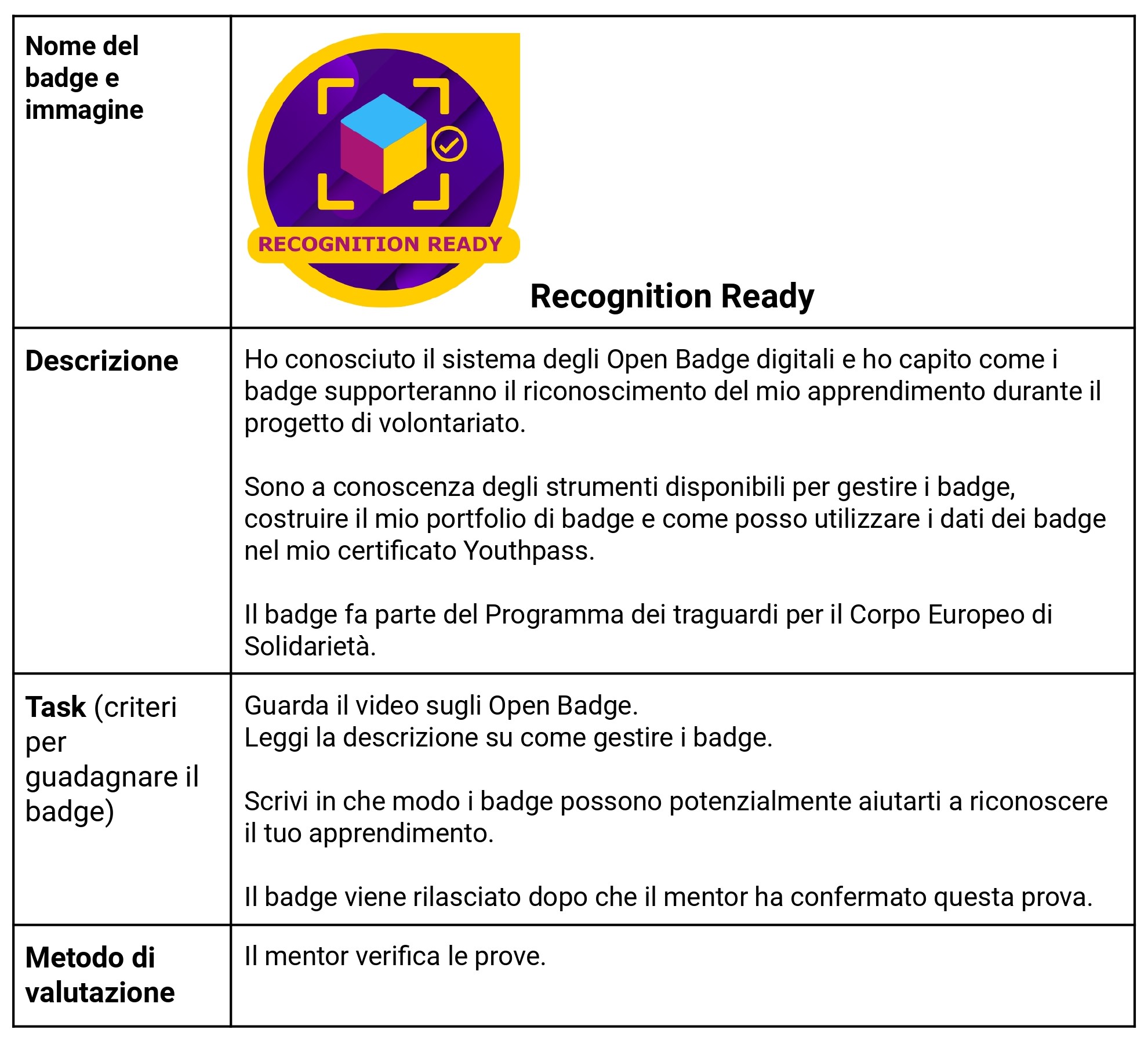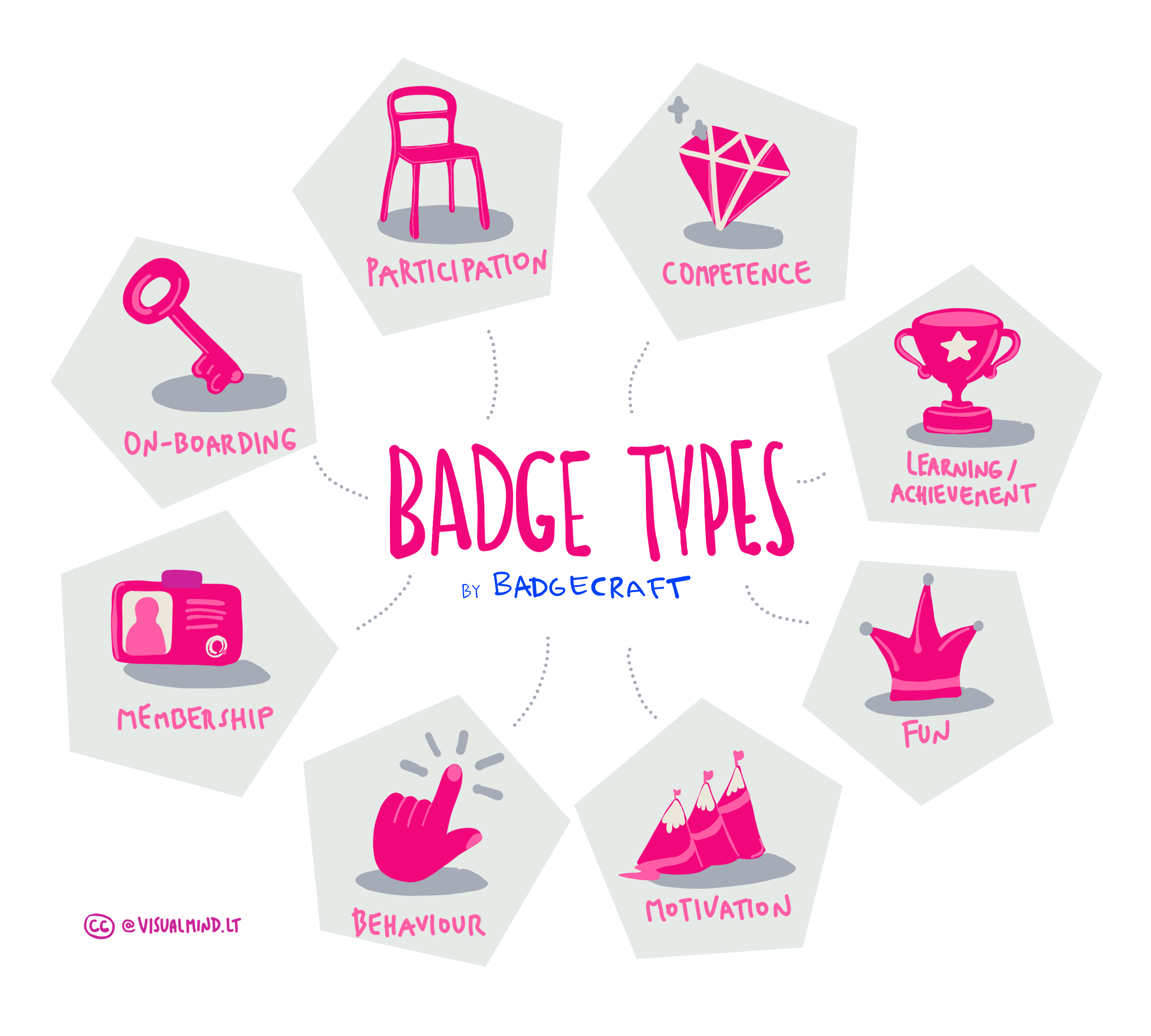1
Come creare un badge di qualità
Come creare un badge di qualità
Informazioni
Ora sai cosa sono gli Open Badge e a cosa possono servire. Guarda questo video per scoprire come creare un buon Open Badge.
Gli Open Badge digitali raccolgono informazioni essenziali sull'apprendimento e sui risultati ottenuti, memorizzando i metadati all'interno dell'immagine del badge.
Se rese pubbliche, queste informazioni possono essere consultate e visualizzate da chiunque. Bisogna prestare particolare attenzione a due delle sezioni da completare nel creare un nuovo badge: la descrizione e i criteri per l'ottenimento del badge.
La descrizione del badge indica a chi lo guarda l'apprendimento avvenuto e i risultati specifici che il badge certifica.
Quando si prepara una descrizione del badge, si possono includere i seguenti dettagli:
- Contesto. Dove e quando è avvenuto l'apprendimento specifico? Quali nuove conoscenze, abilità o cambiamenti sono avvenuti in seguito all'apprendimento? Che tipo di risultato specifico è stato raggiunto?
- Attività completate. Cosa ha completato chi ha ottenuto il badge per ottenere questo badge? Quali ruoli o attività ha svolto chi ha ottenuto il badge? Quali prove ha presentato per rivendicare questo risultato?
- Procedure di valutazione. Quali procedure di valutazione sono state messe in atto per verificare le prove del badge? Chi è stato coinvolto e come è stata effettuata la valutazione?
- Sbloccare nuove opportunità. Quali nuove opportunità può offrire questo badge? Indica tutte le possibilità che questo badge sblocca.
- Collegamenti con un quadro più ampio. Anche se questa informazione può essere inclusa come campo dati separato nel badge, non guasta menzionare se questo badge dimostra competenze che fanno parte di un quadro di competenze più ampio o di uno standard educativo o se si collega a un livello di istruzione specifico (vedi ad esempio come allineare i badge con il quadro DigiComp 2.1). Aggiungendo queste informazioni, sarà più facile valutare l'apprendimento precedente in relazione al livello EQF pertinente.
- Tempo impiegato per ottenere il badge. Questa informazione è importante perché fornisce informazioni su quanto tempo si è “lavorato” per ottenere il badge. Se una persona ha lavorato 3 ore o 6 mesi per ottenere il badge, questo fa la differenza.
Suggerimenti e consigli per la descrizione dei badge
Ecco alcuni suggerimenti da considerare quando si definisce lo stile della descrizione del badge:
- I badge verranno visualizzati da un pubblico eterogeneo: chi ottiene il badge, i futuri datori di lavoro, insegnanti e professori... Lo stile di scrittura che hai scelto è adatto al contesto in cui il badge verrà utilizzato o visualizzato?
- Una descrizione giocosa del badge può motivare i partecipanti, ma può essere presa meno sul serio in contesti più formali. È bene testare i badge con un pubblico mirato. Lo stile dipende anche da chi verifica il conseguimento del badge e le prove.
- La descrizione di un badge può essere scritta in prima persona se il conseguimento e le prove del badge sono auto-approvati da chi ha ottenuto il badge. Nel caso in cui i badge siano rilasciati dagli organizzatori, invece, si può usare la prospettiva della terza persona per descrivere i risultati ottenuti da chi li ha ottenuti.
- Poiché i badge saranno visualizzati sul web, è bene che la descrizione del badge contenga informazioni sufficienti a comprendere il risultato e il suo contesto.
- I metadati dei badge sono leggibili dai computer. Ciò significa che le informazioni sui badge possono essere scoperte dagli algoritmi di ricerca e filtrate di conseguenza. È bene tenere presente alcune parole chiave che possono facilitare la ricerca di un badge.
Come descrivere i criteri per ottenere i badge
Insieme alla descrizione del badge, questa è forse la seconda cosa che chi vede un badge guarderà.
I criteri devono essere molto chiari sia per chi ottiene il badge sia per chi lo guarda dall'esterno.
- I criteri devono stabilire obiettivi specifici per chi ottiene il badge, ovvero cosa si deve fare e cosa bisogna raggiungere. Devono descrivere quali prove devono essere fornite: testo, immagini o qualsiasi altro tipo di file.
- Processo di valutazione. Deve indicare chiaramente come il badge verrà valutato: dal partecipante stesso, dai suoi pari, oppure dal formatore o dal responsabile del programma.
- Cerca di creare criteri che non siano troppo complessi. Piuttosto, è bene suddividere un badge complesso in badge più facili da ottenere.
- Alcuni badge possono non richiedere il caricamento di prove, ma possono richiedere il conseguimento di altri badge propedeutici. Specificalo nei criteri.
Qui di seguito sono riportati alcuni esempi di descrizioni di badge di qualità. Questi badge sono stati creati per riconoscere l'apprendimento dei volontari internazionali.
In questo esempio, si può notare che gli autori del sistema di badge hanno scelto di utilizzare una descrizione del badge in prima persona. Questo è stato fatto intenzionalmente perché quando un volontario condivide il proprio badge, il messaggio proviene dalla prospettiva del proprietario del badge.
Nelle attività che seguono scopriremo i vari tipi di badge. Questo badge serve come badge di benvenuto. In altre parole, ha lo scopo di motivare chi guadagna i badge a interessarsi e a conoscere gli Open Badge prima di addentrarsi nell'intero percorso.
Si può notare che il primo badge è piuttosto semplice in termini di realizzazione: c'è solo un'attività da svolgere e il badge viene guadagnato completando questo compito e facendo approvare le prove dal mentor.
Quando si imposta un badge sulla piattaforma Cities of Learning, è possibile aggiungere competenze specifiche da un quadro di competenze prescelto. In questo modo, si collegherà il badge al contesto più ampio dello sviluppo delle competenze.

Ecco un altro esempio di badge, ma questo è molto più complesso: il partecipante può ottenere questo badge solo quando almeno 2 dei 3 compiti sono stati completati e le prove sono state approvate dal mentor.
Questo badge è collegato a una delle Competenze chiave per l'apprendimento permanente - Competenza personale e sociale.

Tipi di badge
I badge possono essere utilizzati per vari motivi e di solito vengono suddivisi in diversi tipi. Tecnologicamente i badge non differiscono e seguono lo stesso standard. Tuttavia, quando si progetta un sistema di badge, è bene suddividere i badge in diversi tipi ed essere consapevoli di ciò che si sta cercando di ottenere con ciascun badge.

- I badge di benvenuto possono essere rilasciati per chi sta imparando a conoscere i badge e a scoprire come verranno utilizzati nel progetto o nell'evento specifico.
- I badge di partecipazione riconoscono o motivano la partecipazione attiva.
- I badge di competenza sono spesso più complessi e possono consistere in badge “minori” che riconoscono conoscenze, abilità o attitudini.
- I badge di apprendimento/risultato sono rilasciati per riconoscere specifici risultati di apprendimento.
- I badge per il divertimento sono spesso i più popolari, perché tutti vogliono divertirsi e un processo di apprendimento divertente dà ulteriore energia e gioia.
- I badge motivazionali potrebbero non riconoscere i risultati finali, bensì essere badge che guidano le persone lungo il percorso e riconoscono i loro sforzi, la loro persistenza e la loro motivazione a continuare.
- I badge comportamentali possono essere dedicati al riconoscimento di comportamenti specifici che ci si aspetta o che si promuovono.
- I badge di appartenenza possono simboleggiare l'appartenenza a uno specifico gruppo, organizzazione, classe, processo.
Quando si esplorano esempi di sistemi di badge, si può notare che molti di essi contengono diversi tipi di badge. Il sistema può iniziare con alcuni badge di benvenuto, per poi proseguire con alcuni badge per la motivazione e la partecipazione e infine con altri badge per l'apprendimento e i risultati ottenuti. Quando si progetta un sistema di badge, è possibile indicare il tipo di badge e l'obiettivo da raggiungere.
Valutazione delle prove e modalità di rilascio dei badge
È possibile scegliere tra diversi modi per rilasciare un badge. Individua il modo migliore per te in relazione agli obiettivi dell'attività e del badge.
- Rilasciare un badge tramite la scansione di un codice QR. Questo è il metodo di emissione generato automaticamente dalla piattaforma (per impostazione predefinita). Questo metodo è adatto soprattutto agli eventi in presenza, quando i partecipanti si recano fisicamente all'attività e gli organizzatori possono decidere quando rilasciare il badge. Utilizzando questo metodo, i partecipanti non aggiungeranno altre prove al badge. Il badge stesso sarà la prova della partecipazione.
- Rilascio del badge via e-mail. Questo metodo è adatto se i partecipanti non possono scansionare il codice QR sul posto o se hanno partecipato a un'attività online e l'organizzatore dispone dei loro indirizzi email.
- Impostare delle attività da svolgere (task) per ottenere un badge. In molti casi è opportuno che il badge non venga rilasciato direttamente, ma venga guadagnato dal partecipante al completamento di determinate attività. L'emittente del badge può definire uno o più compiti/task per ogni badge e richiedere al partecipante di caricare delle prove (qualsiasi tipo di file, come ad es. una riflessione scritta, un'immagine, un link, ecc.)
L'organizzatore può impostare la valutazione in tre modi diversi:
- Autovalutazione. Le prove vengono auto-approvate al momento del caricamento. Questo è un buon metodo se il processo di apprendimento si basa sulla fiducia e sull'autoriflessione. Non tutto l'apprendimento ha bisogno di essere valutato da persone esterne.
- Valutazione tra pari. È possibile stabilire un certo numero di partecipanti alla stessa attività che devono approvare le prove. Solo allora verrà rilasciato il badge. Questo metodo è utile quando l'attività coinvolge più persone nella realizzazione di alcuni compiti.
- Valutazione esterna. Questo metodo è adatto se gli organizzatori dell'attività sono disposti a esaminare le prove e hanno il potere di verificarle e approvarle. È l'approccio più top-down ed è adatto a programmi educativi più rigidi.

Risorse utili
- Download a Word version of a worksheet to create quality Open Badge(s)
- Download a PDF version of a worksheet to create quality Open Badge(s)
- Scarica il modello da compilare per descrivere i tuoi badge in italiano (Word)
- Scarica il modello da compilare per descrivere i tuoi badge in italiano (pdf)
- Scarica la checklist per valutare la qualità dei tuoi badge in italiano (Word)
- Scarica la checklist per valutare la qualità dei tuoi badge in italiano (pdf)
- Ženkliuko kokybės pasitikrinimo sąrašas_Lietuviškai (word)
- Ženkliuko kokybės pasitikrinimo sąrašas_Lietuviškai (PDF)
- Ženkliuko aprašymo šablonas
Ottieni badge per l'attività
Quality Badge Creator Ottieni questo badge
Questo badge dimostra la mia abilità nel creare una descrizione di qualità dei badge, con compiti da svolgere significativi e un processo di valutazione adatto.
Per ottenere questo badge, ho dovuto fornire 1) una descrizione del badge seguendo un modello specifico, 2) una checklist della qualità dei badge, e tenere conto delle raccomandazioni per una descrizione di qualità dei badge.
Questo badge viene rilasciato nell'ambito del corso online che porta al conseguimento del Quality Label per Badge digitali.
Attività
Task n.1
Prova verificata da: un organizzatore dell'attività
Descrivi il tuo Open Badge e conferma di aver incluso tutte le informazioni. Usa le caselle del documento per rispondere alle domande della checklist. Questo ti permetterà di sviluppare le tue capacità di analisi della descrizione dei badge e di verificare se hai incluso tutti i dati necessari.
Carica poi il documento compilato come prova.
Organizzatori
Cities of Learning Network
Emittente di badge certificato con
L'organizzazione no-profit Awero gestisce questa piattaforma web e continua a svilupparla in partnership con organizzazioni leader nel settore dell'educazione. La prima versione di questa piattaforma è stata realizzata grazie ai cofinanziamenti del programma Erasmus+ dell'Unione Europea. Contattaci all'email support@awero.org.
Piattaforma
Cambia lingua:

